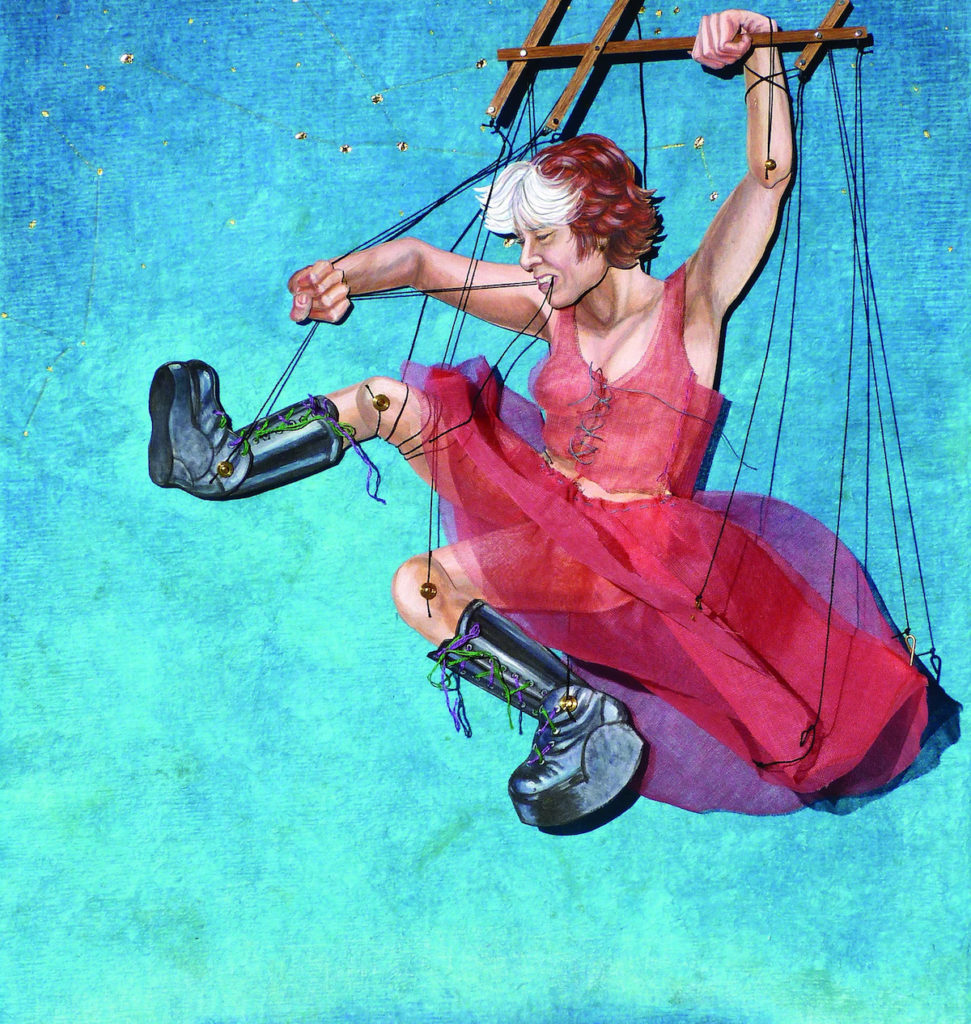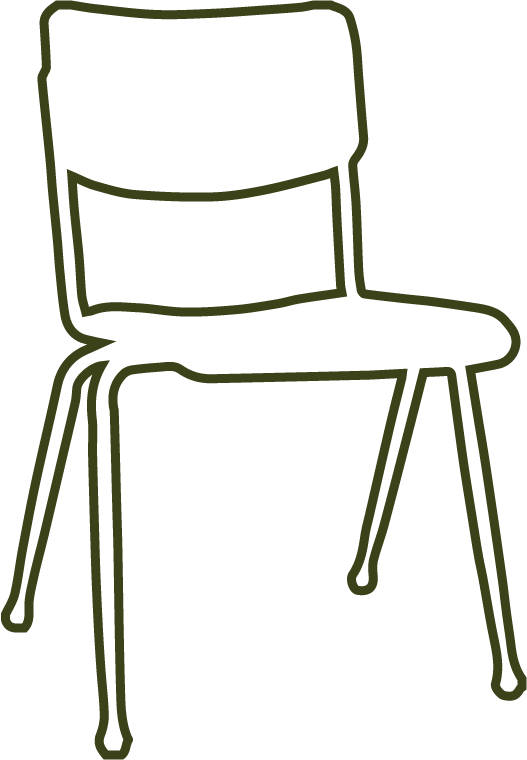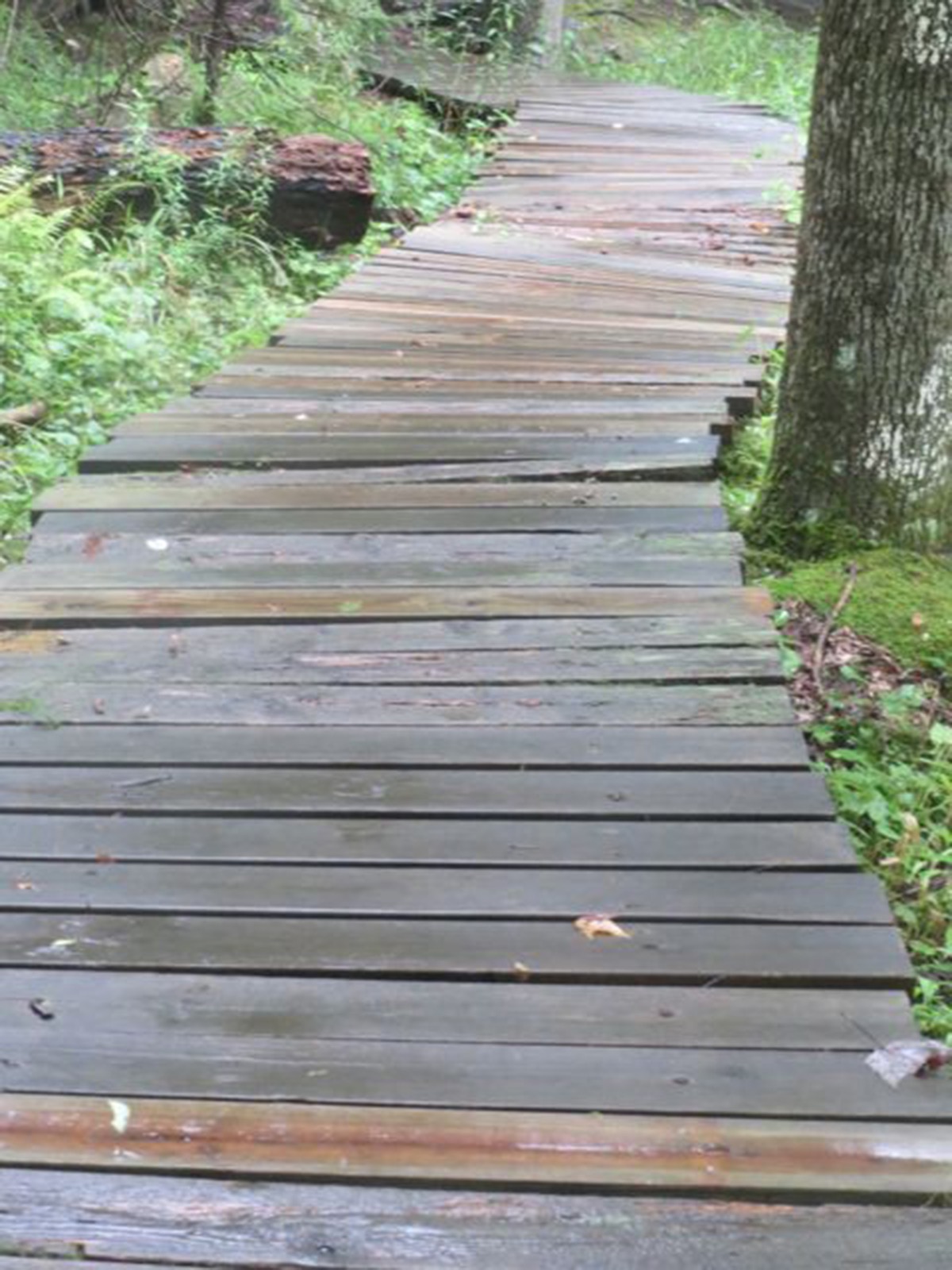Anne: When we present an early version of this chapter at the 2014 conference of the Society for Disability Studies, Riva Lehrer asks why we begin our challenge to access in “ambivalence, rather from the space that is implacable.” In giving our attention to the ambivalent interfaces of bodies and environment, she queries, are we refusing to acknowledge the reality of impairments that cannot be accommodated?
We know that many impairments cannot be accommodated. Can we enlarge our language and that of Disability Studies to accommodate this? I am re-tracing these questions, as my husband Jeff and I move slowly across a boardwalk, snaking through a bog in Canaan Valley, West Virginia. It is a rainy afternoon in August, and the walkway is slick. We know this, and are taking it gingerly, when, on an incline, I start to slip…and can’t stop. Seen from outside, the scene must be hilarious: I slide, and slowly turn, before landing (surely with a plop!) on my back, in the bog. Experienced from the inside, though, there is no room for laughter. As I slide, inexorably, and turn, inflexibly, I feel a pain—excruciating, in my right knee. When I try to get up, it’s totally non-negotiable: I cannot put any weight on my leg. And there it is, in a moment: the implacable.
Implacable, too, are my needs over the next few weeks, as I am displaced from agile mind to immobile body, as I hobble, and ice, and ask for assistance from Jeff who is, in turn, (un)fairly implacable in his judgment of what needs I (think I) have, what needs he thinks need meeting. We negotiate, or I do without, when he will not accommodate.
That fall, I return to Bryn Mawr, moving with less pain, although still using a cane—and encounter an agitated warning from our new access coordinator: all needs must be met. Or else. In a steadily rising tone, she writes me about the college’s legal obligations to a student who has told us of her needs too late for us to accommodate them all:
And yet, it turns out, there is nothing implacable there. Getting to know the student, introducing her to the administrator who is scanning our documents, we together work our way through the syllabus, identify what needs to be re-scanned to be made audible, agree to do so on a workable timetable.
A month after the administrator, my student, and I reach accommodation, Riva arrives on campus, to serve as the creative consultant for a cluster of courses, a 360° I am co-teaching on “Identity Matters.”See Chapter 8, “Slipping.” When Riva first comes to my class, she asks us all to begin to imagine—and then to draw—the “invisible body of desire”: what we would look like, if we were completely unbound by any restrictions? What could we do as an entity, if all constraints—gravity, time, whatever holds us back from being whatever we might be (everything implacable?)—were lifted?
To get to this place, she asks us first to think to our last vacation, our last really enjoyable time—
I was on vacation when I slipped and tore that ligament—
and then back to a longer vacation, a time freed from responsibility and obligation, centered around what we always wanted to do—and then even further back, to the seventh grade, when we were beginning to dream about what we wanted to be. How were these states connected? Where did they make a “turn”? When did our desires change? What might have happened in our lives, if we had gotten to do completely what we wanted to do when we were twelve?
All constraints lifted, all choices totally open: what powers do we have? What are our minds and hearts good at doing? Peeling back from the everyday to much older motives: what moves us now at the essential level? “Build a body that lets you be that entity,” Riva says (as she has done, in a self-portrait called “At 54”).

Her invitation is a way to enter students’ psychic spaces, to seek, under their own direction, what they most long for—in the language of crip ecology—“to open up desire for what disability disrupts.”Elizabeth Chandler, “Cripping Community: New Meanings,” No More Pot Lucks, September 5, 2013.
And so it is really Riva who articulates, first at the conference, then in my class, the tension that animates this chapter: the stretch between what is implacable, cannot be negotiated, and what is desired: flexible minds, bodies, social spaces. Mobile. Unbound. Pliable. Placable. Changing the circumstances in which the self finds herself. Mediating between what is necessary and what is impossible, what is wanted and what is do-able. In flesh and feeling, both constrained and reaching.
The swing between implacability and desire, between what cannot be negotiated and what can be dreamed, is ever on-going, always inviting renovation. I learn these lessons—the need to attend, the difficulty of doing so, the im/possibilities of responding appropriately, the invention of new possibilities—again and again throughout the following semester, as Riva and I co-teach “Identity Matters” with Kristin Lindgren, who directs Haverford College’s Writing Center, and Sarah Bressi, of Bryn Mawr’s Graduate School of Social Work and Social Research. Partly because of our topic, partly because of the structure of profound engagement that a 360° entails, partly because of the particular mix of individuals who gather to share this project, the work of this cluster makes transparent the on-going, back-and-forth, ever-unsettling and unsettled process of access and accommodation in teaching and learning. We desire. Adjust. Long for something more or else. Recalibrate. Thread in and out of our shifting environment.
For the twelve students enrolled in this particular group of courses, who represent a variety of classes, races, genders, and dis/abilities, the focus on “identity matters” makes this project intensely personal from the get-go. Fed from multiple directions
—the students’ own investments, and ours (Riva’s creative exercises, Kristin’s course on disability, Sara’s on aging, mine on feminism)—we give extended attention to the interpersonal dynamics of accessibility and accommodation, hold repeated discussions about how we speak with one another, how we listen to what was said, how we might grant respect to every class member. Wishing. Stumbling. Wanting. Exhausting. Aspiring. Up and through the semester’s end: on-going negotiating of constraints and longings. Our group effort constitutes another instantiation of “crip ecology,” shifting our environment as it shapes and shifts us.
Our classroom is filled with desires—all compelling, all legitimate—and incapable of being fulfilled in the same place at the same time. “Accommodation” is an “assembling” and re-assembling that never settles, is never fully accommodated.
Throughout this essay, we move from speaking of “access,” which signifies a capacious, radical vision of the equal participation in society of persons with disabilities; to describing “accommodation,” which signals more narrow, specific strategies (such as extra time for testing, or large print texts). We also evoke the concept of “universal design,” which, as Jay Dolmage observes, “often usefully syncs with” accommodation, but also critiques that model with a more profound sense of “the actual, tricky, ongoing negotiations of classroom practice,” a recognition that there will never be a “grand solution.”Dolmage, “Universal Design.”
Our own relationship to each of these orientations also shifts from that of critique to syncopation and back again. For instance, we accept Jay’s description of universal design for learning as offering “places to start thinking, doing, acting and moving,” always aware that any teaching strategy that offers a “good solution in the classroom” will also inevitably create “conflicts of access.”Dolmage, “Universal Design.”
My students’ postings form a collage of such conflicts: different, often competing, capacities and checks, needs and wants.
Another student, who is a McBride (one of a cohort of women over the age of 24, who did not complete college immediately after high school), reports on the “unexpected invisibility of being a McBride”:
Realizing that such anxieties frequently lead her to bring her personal experience into class discussion—and that these are significant expressions of her longing to belong—she challenges Hummingbird for using the privilege of upper-class politeness to silence her, refusing her the right to speak in her accustomed mode.
Other students, largely silent to this point, also begin to write about their experiences of the in/accessible:
The student consultant we’ve engaged through Bryn Mawr’s Teaching and Learning Institute“Teaching and Learning Institute at Bryn Mawr and Haverford Colleges.”4 reports that one-or-some students think that I should intervene more in class, to keep people from getting cut off, and/or direct the discussion more. Knowing we disagree on what “respect” sounds like, and also that different ones of us prefer different pacings, I propose that we share this labor: asking for some other voices in the conversation, being more aware of what’s going on, not so caught up in what we want to say that we don’t look around, pay attention to others’ body language, making sure—especially if we’ve already spoken—that others aren’t wanting to speak before we speak again; try a breath in between. These gestures—pushing ourselves to speak if we haven’t, pushing ourselves to be still if we have already talked in any given session—are all forms of accommodation, ways in which we and our environment continue to respond to one another.
We expend much effort before recognizing the essential incompletability of this project. We can’t achieve the total access we desire—and we can’t stop trying to.
At semester’s end, Hummingbird testifies that her contributions in class aren’t taken up in the way she expects. Her story is a tangle of not being able to understand, and of not being understandable, of her “words taking on meanings” she doesn’t intend. All of this in the context of love—of a deep, familial longing for connection:
In early November, we are trained into a more disciplined practice of speaking and listening. We attend a public performance of “Two Women Talking,” by Bryn Mawr alum Monsoon Bissell and her good friend Benaifer Bhadha; then an all-day workshop, just for our group, on their “narrativ” method. Learning how to implement careful listening: to clear our minds of obstacles that might prevent us from being fully present and receptive, as we prepare “listening bowls” to catch one another’s stories. A student explains the first step: “Imagine that the words coming out of your mouth are filling a bowl. In order for your words to be received well you must ‘clear your bowl.’ Simply name all the things that may hinder you from listening.” Another student elaborates: “Take a moment and think about…the space you offer up when you agree to listen to someone. We all have a variety of bowls (shallow, deep, tall, wide), and we are offering up our biggest bowl when we are most ready to listen.” Final Booklet, December 9, 2015. During the weeks after, we are able to put such exercises to repeated good use in class. I am particularly heartened when some students who have been in conflict organize their own “listening conversations,” and report back that they’ve learned to “widen and deepen” their bowls.
And yet, as the semester draws to a close, two other students, who are very angry with one another, are telling the same story: each posts something on-line that gets no response, and so feels invisible, not listened to. Two others tell counter-stories: they read their classmates’ posts, have no words to respond. I observe that we all have been, and have had, sustained silent readers throughout the semester. Sometimes we don’t realize this: we are being seen, listened to.
When we gather for our last class, I invite the students into a closing ceremony, designed by Alice Lesnick, which figures this understanding. Calling attention to the beautiful bowl I have set in the center of our circle, “fragile but capable of holding whatever we put in it,” I instruct the students to place in the vessel something they want to leave there; then, on a second round, to demonstrate and articulate what they are carrying out. To do this in an embodied way, considering the shape and weight of these things… .
I say, drawing on a powerful image offered by one student, that the bowl “has been here all along, and it isn’t yet filled.” I see it holding the fear of another student that our upcoming public listening conversation “isn’t focused where our priorities should be, on police brutality,” the sense yet another has of “being suffocated by too much information,” the apology of a fourth for a lack of presence, the awareness of a fifth of “our continued shared martyrdom,” even a sixth student’s “feeling bad that they’re not feeling bad.”
The “listening bowl” marks the fullness of possibility, without insisting on its full realization (which probably, anyway, can’t be found in words…). Learning what is wanted is a process. The bowl is both a metaphoric way for each of us to attend to what one another has to say, and—without choosing one mode of access over another, or ever reaching full accommodation—it figures a means of experiencing the material classroom, intermittently, as an “imagined community.”Benedict Anderson, Imagined Communities: Reflections on the Origin and Spread of Nationalism, rev. ed. (Brooklyn: Verso, 2006).
This, again, is ecology “cripped,” unsettling what we think we know in favor of interruption and disturbance, unveiling new imaginings that unfold in how we live our lives, enact our selves, interact with all that surrounds and moves through us.
There are, to be sure, cracks in this bowl. But there’s a sufficiency here, too—and a space to hold it all. Longings deeply linked with the capacity to imagine otherwise. Filled with failure that is also, always, a mark of desire. A “holding environment”C.f. D.W. Winnicott, Maturational Processes and the Facilitating Environment: Studies in the Theory of Emotional Development (1957–1963; rpt. London: Karnac Books, 1996).—not as permanent, but as a space of learning, to return to as needed.

